How to Adjust the Display Brightness in Windows 11
Regardless if you’re using a Windows 11 desktop, laptop or notebook, you’ll likely want to adjust the brightness level of your display at some point in time. Especially if you use your Windows 11 laptop intermittently outdoors and in dim-lit rooms.
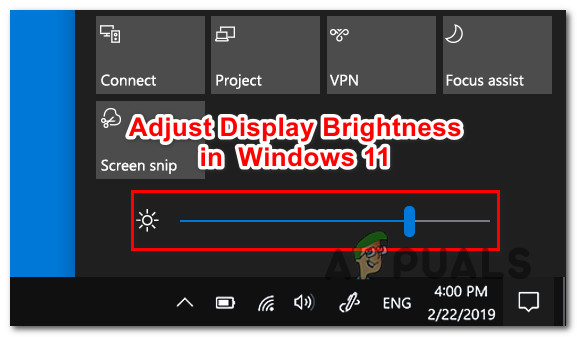
Certain PCs are capable of adjusting the brightness of your Windows 11 screen automatically, but there will certainly be times where you’ll want to take full control over your screen brightness level. Just keep in in mind that the brighter your screen is, the more battery it uses.
In order to help you take full control over your screen brightness, we’ve put together a comprehensive tutorial that contains all the ways that you can use to adjust the brightness level of your Windows 11 computer.
Here’s a short list of methods that you can use to adjust the display brightness of your Windows 11 PC:
- Adjust the Display Brightness via OSD (On-Screen Display) settings
- Adjust the Display Brightness via connected keyboard
- Adjust the Display Brightness via Quick Settings
- Adjust the Display Brightness via Settings
- Adjust the Display Brightness via Windows Terminal
- Adjust the Display Brightness via Command Prompt
- Adjust the Display Brightness via Mobility Center
- Adjust the Display Brightness via Intel Graphics Control Panel
- Adjust the Display Brightness via Nvidia Control Panel
Important: The Change brightness display slider might not be available on desktop PCs that have an external monitor – In this case, you should change the brightness of your external monitor by using the physical buttons on your display.
Adjust the Display Brightness using the On-Screen Display (OSD) settings
Note: This option can only be used on Windows 11 PCs with external displays (or all-in-1 PCs).
The instructions for accessing the OSD settings of your particular display and adjusting the brightness level will be specific from manufacturer to manufacturer.
Most commonly, you’ll need to press the Menu button to access the OSD Settings, then look for the Picture settings tab where you can adjust the brightness level.

Note: Some displays will shape a separate button or even a knob that will allow you to adjust the display brightness.
Adjust the Screen Brightness by using Keyboard shortcuts
Note: This option will only work on Windows 11 computers with a built-in display.
The vast majority of laptops, notebooks, and ultrabooks will feature shortcut keys that you can specifically use to adjust the brightness of your display. Most commonly the laptop manufacturers will use F2 + F3, F5 + F6 or F11 + F12 as the brightness control keys.
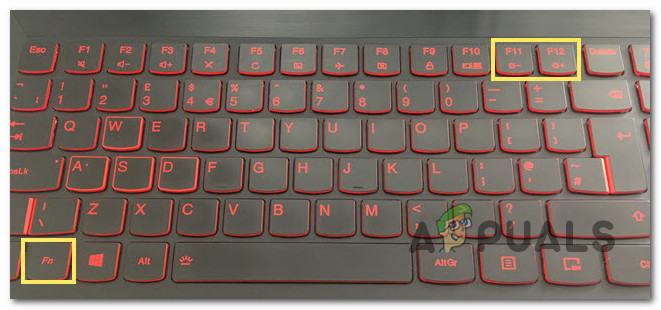
But in order to adjust the brightness, you will also need to keep the Fn key pressed. So, for example, if your laptop has the brightness shortcut keys on F2 and F3, you’ll need to press FN + F2 to bring your screen brightness down and FN + F3 to bring it up.
Note: The exact keyboard shortcuts for the brightness adjustment will be different from manufacturer to manufacturer. The best course of action is to look at your laptop’s keyboard to discover the brightness keys. If the symbols on your keyboard are no longer visible, consult the official manually or look online for the specific keys according to your laptop model.
Adjust the Display Brightness from the Quick Settings menu
Note: This option will only work on a PC with built-in displays.
- Press the Windows key + A to bring up the Quick Settings menu. Additionally, you can click on your battery / Wi-Fi/ sound icon cluster (bottom-right corner of the screen).

Accessing the Quick menu - Once you’re inside the Quick Settings menu, simply adjust the brightness slider from the bottom of the menu.
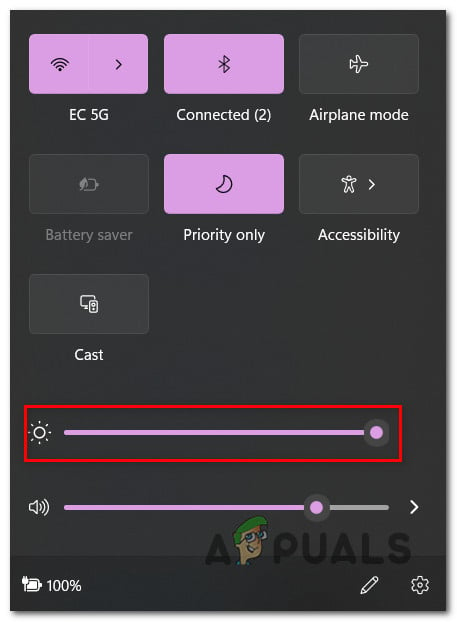
Adjusting the Brightness slider
Adjust the Display Brightness from the Settings menu
- Press Windows key + I to open up the Settings menu on Windows 11.
- Once you’re inside the Settings menu, click on System from the tab on the left, then move over to the right-hand section and click on Display to expand the drop-down menu.
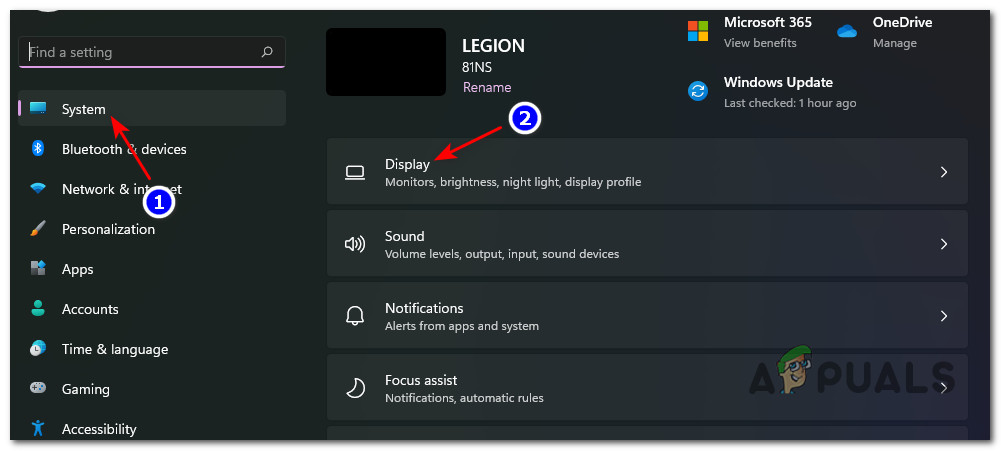
Accessing the Display settings - Once you’re inside the Display tab, simply use the Brightness slider (under Brightness & color) to adjust the brightness of your display manually.
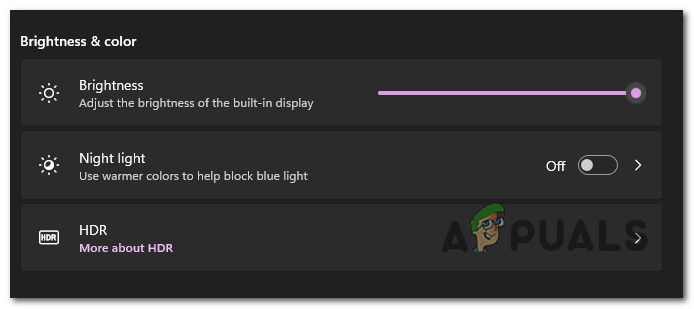
Adjust the brightness of your display Note: Additionally, you can check the box associated with Change brightness automatically when lighting changes to let your system adjust the brightness automatically. But keep in mind that this needs to be supported by your built-in display.
- Once the modification has been made, the changes will be visible immediately. When you’re done, you can safely close the Settings window.
Adjust the Display Brightness using Windows Terminal
Note: You’ll only be able to follow this method if you’re using a Windows 11 PC with a built-in display.
- Press Windows key + X key to open up the quick link menu. Next, from the list of available options, click on Windows Terminal. If you’re prompted by the User Account Control (UAC) window, click Yes to grant administrative privileges.
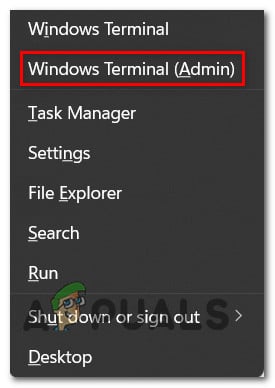
Accessing the Windows Terminal app - Once you’re inside the Windows Terminal app, type the following Powershell command, adjust it to your preferences and press Enter to adjust the brightness level of your display:
(Get-WmiObject -Namespace root/WMI -Class WmiMonitorBrightnessMethods).WmiSetBrightness(1,<Brightness Level>)
Note: Keep in mind that <Brightness Level> is simply a placeholder for the percentage brightness level you want to set up. Substitute the placeholder from 0 to 100 depending on the brightness percentage you want. For example, here’s a command that will set your brightness level to 35%:
(Get-WmiObject -Namespace root/WMI -Class WmiMonitorBrightnessMethods).WmiSetBrightness(1,35)
- After the command has been successfully processed, you can safely close the Windows Terminal window.
Adjust the Display Brightness using Command Prompt
Note: This method will only work for Windows 11 PCs with built-in display solutions.
- Press Windows key + R to open up a Run dialog box. Next, type ‘cmd’ inside the text box and press Ctrl + Shift + Enter to open up an elevated Command Prompt window.
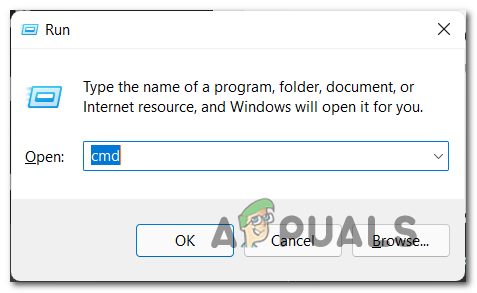
Opening an elevated CMD prompt - At the User Account Control prompt, click Yes to grant administrative access.
- Inside the elevated CMD prompt, type the following command, make the necessary changes and press Enter to change the current brightness level of your built-in display:
powershell (Get-WmiObject -Namespace root/WMI -Class WmiMonitorBrightnessMethods).WmiSetBrightness(1,<Brightness Level>)
Note: Keep in mind that <Brightness Level> is simply a placeholder. You’ll need to replace <Brightness Level> with the percentage of the brightness level that you want. For example, if you want to set your Brightness Level to 100%, use the following command:
powershell (Get-WmiObject -Namespace root/WMI -Class WmiMonitorBrightnessMethods).WmiSetBrightness(1,100)
- Once the command has been processed, you should see your screen brightness changing immediately. At this point, you can safely close the elevated Command Prompt.
Adjust the Brightness of Your Display via the Mobility Center
Note: You’ll only be able to follow the instructions below if you’re using a laptop that comes with Intel’s Mobility Center pre-installed.
- Press Windows key + X key to open up the quick link menu on Windows 11, then click on Mobility Center from the list of available options.

Opening up the quick link menu on Windows 11 - Once you’re inside the main menu of the Windows Mobility Center, use the Display brightness slider to adjust the brightness according to the level that you want.
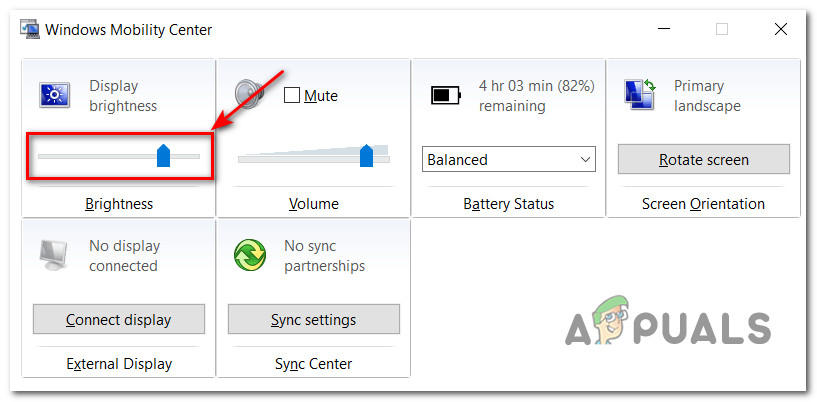
Adjusting the brightness via the Windows mobility center - When you’re finished with the adjustment of your screen brightness via the Mobility Center interface, you can safely close it.
Adjust the Display Brightness via the Intel Graphics Control Panel menu
- Press the Windows key to bring up the Start menu, then search for the Intel Graphics Control Panel menu.
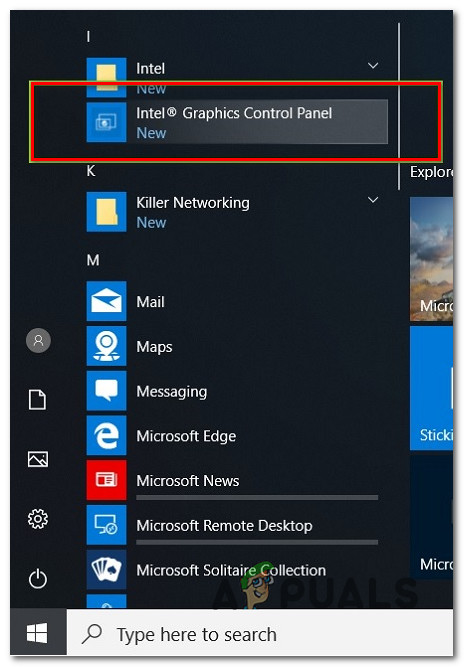
Accessing the Intel Graphics Control Panel - Once you’re inside the Intel Graphics Control Panel, click on the Display icon in the bottom-left corner of the screen.
- Inside the Display tab, select the Color Settings from the vertical menu on the left.

Accessing the Display menu - Next, move over to the right-hand pane, select the display you want to modify the brightness of using the Select Display drop-down menu, then adjust the Brightness slider as per your convenience.
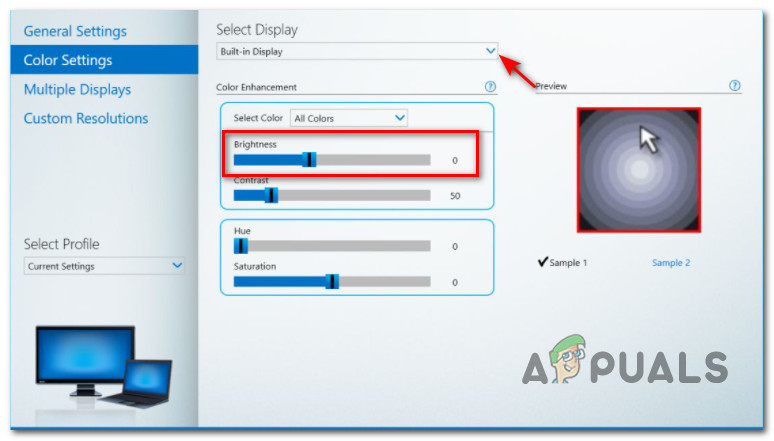
Modifying the Brightness slider - Click Yes to confirm and enforce the changes that you just made to your brightness level.
Note: Keep in mind that unless you confirm the choice within 15 seconds, the changes will be reverted back to their initial values. - When you’re finished, you can close the Intel Graphics Control Panel as the changes are already permanent.
Adjust the Screen Brightness via Nvidia Control Panel
Note: This method is only applicable as long as you’re using an Nvidia GPU and you have the Nvidia drivers installed.
- Open up the Nvidia Control panel via the taskbar icon, by searching for the app via the Start menu (press Windows key) or by right-clicking on a free space on your desktop and clicking on Nvidia Control Panel from the context menu that just appeared.

Opening the Nvidia Control Panel Note: You might need to click on Show More Options in order to see the NVIDIA Control Panel options.
- Once you’re inside the main menu of Nvidia Control Panel, click on Adjust desktop color settings link under Display in the left pane.
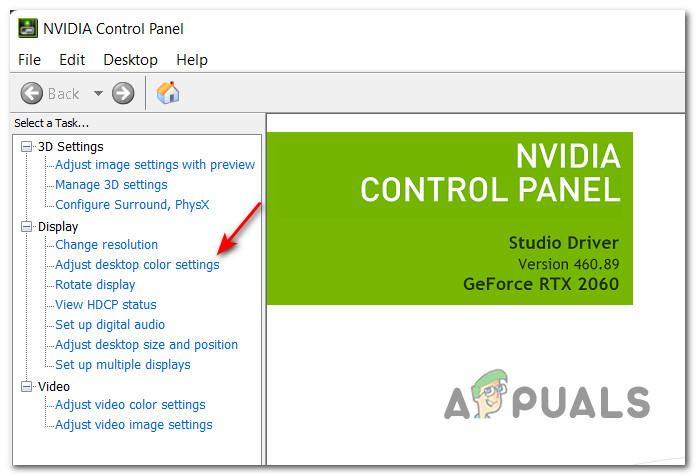
Accessing the Desktop Color settings Note: if this is the first time you’re opening Nvidia Control Panel, you will need to accept the License Agreement first by clicking on Agree and Continue.
- If you have more than one display connected to your Windows 11 PC, you’ll need to select the display that you want to adjust the brightness first from the right side.
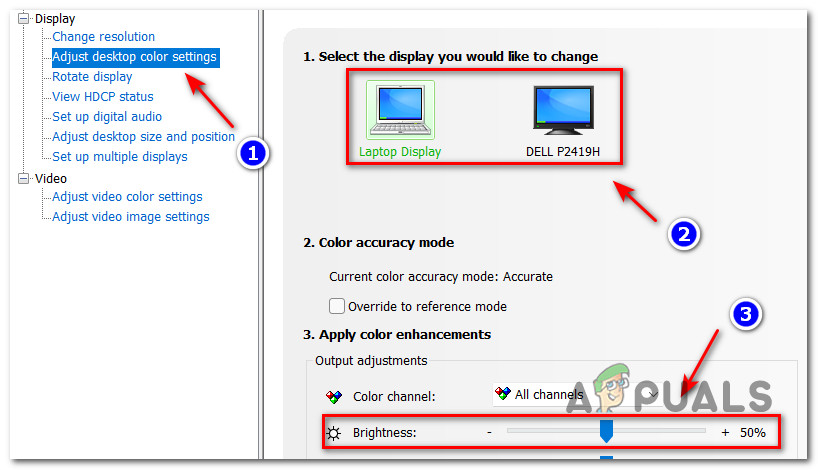
Adjusting the Brightness level via Nvidia Control Panel - Next, scroll down to Output adjustments and drag the Brightness slider left or right depending on if you want to tone down or boost your screen brightness.





